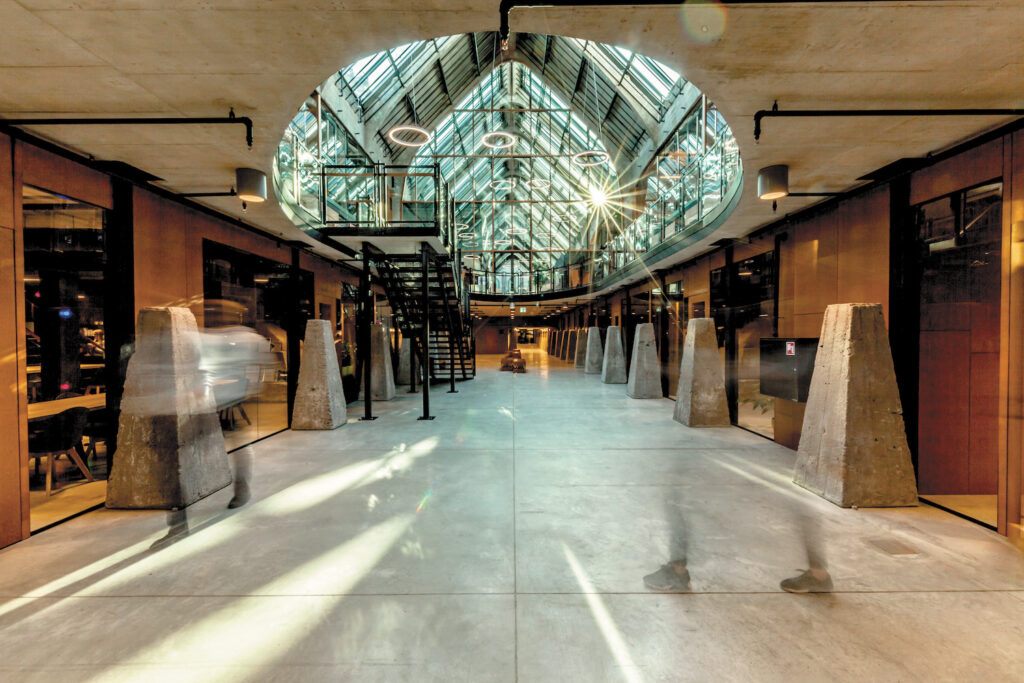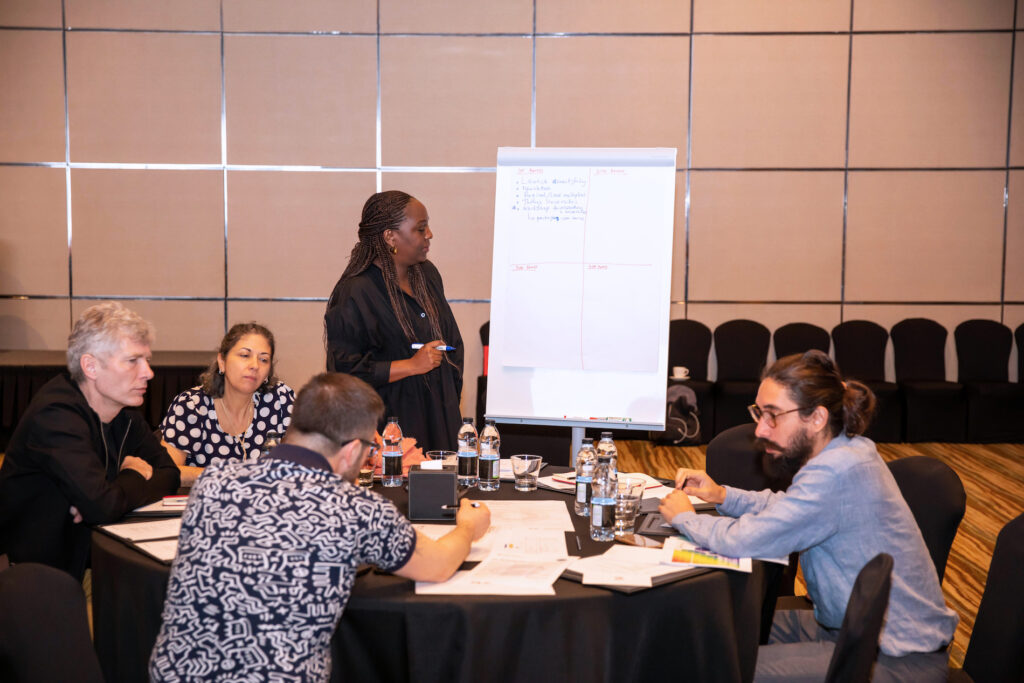Urmo Vaikla is an interior architect and, since 2017, an executive board member of the International Federation of Interior Architects/Designers (IFI). We reached out to him to discuss the current state of interior architecture and the challenges it faces in the contemporary world.
How do you see the place of Estonian interior architecture in the wider world? What could be our distinctive contribution?
Above all, we can offer our experience. Estonian interior architecture is of high quality and has a rather long history. A couple of years ago, we celebrated the 80th year of interior architecture education, which is hardly usual in the global context. In Estonia, there is a tradition of involving an interior architect in addition to the architect in planning a building. For the last ten years, the Estonian Association of Interior Architects has been an active member of umbrella organisations (IFI and ECIA), organised professional symposia and kept up international communication. I truly hope that this level of activity will continue. I find it extremely important to look beyond one’s sandbox with a curious eye, and to relate with the rest of the world. The fact that the world is an integral whole and every local problem could rapidly turn into a global one (or vice versa) can certainly be seen from the current spread of the coronavirus, not to mention climate change, global waste, race and gender issues as well as other things, all of which also concern interior architecture—a discipline most directly involved with human activity and living environment. It is impossible to engage in these global matters without the exchange of knowledge and skills.
What is currently topical on the international scene of interior architecture? Where is IFI steering its development?
One of the main goals of IFI is to consolidate the professional interior architecture community—through its member organisations, the network now connects more than a quarter of a million of interior architects and academics—so that they could notice and solve various kinds of issues by the means of spatial design. It provides a way for interior architects to change or improve the world. One idea that was repeatedly voiced at the last IFI congress is that local, country-specific problems often find solutions namely through international practice and experience, without losing any of the local touch. Perhaps the greatest challenge in the present-day information society is how to be modern, perceive and reflect on important topics and trends, while using the methods distinctive to a local culture.

IFI speaks of design for everybody, sustainability, the social, economic and environmental effects of interior architecture, etc. The themes of the IFI-organised World Interiors Day also show what is topical in the global context: in 2018, the theme was Design Without Borders; in 2019, it was Designing Spaces Changing Lives; this year, it was Nexus Interiors. It has been decided that the next year’s theme is going to be Design as Conversation.
This year, IFI expanded its award programme. What kinds of values in interior architecture were recognised?
For the first time, IFI awarded the ambitious IFI Prize, which is likened to the Pritzker Architecture Prize, meaning that it is the highest recognition for an individual or collective in the field of interior architecture. The first to earn this recognition was Arthur Gensler, American architect and founder of the eponymous design firm, whose notable projects include Shanghai Tower (2013) and San Francisco International Airport (2011). The IFI Design Journalism Award (IFI DJA), which has also been awarded in the previous years, was given this time to Alice Rawsthorn, a design critic and author of several books who has worked as a correspondent for the Financial Times in 1985-2001, headed the London Design Museum in 2001-2006 and served on the juries of several prestigious architecture and design awards, such as the Turner Prize, Stirling Prize and Rome Prize. But, most gratifyingly, some Estonian firms were also recognised: among the first-time awards for interior architecture projects, the gold prize in the entry category ‘Work’ went to HG Arhitektuur for Luther’s Machinery Hall, and the entry category ‘Humanitarian’ included KAOS Arhitektid with its Vastseliina Pilgrims’ House as a finalist. This is a worthy recognition, all the more so given that the jury consisted of some of the world’s tops. The criteria of evaluation included originality and authenticity, functionality, quality of the design, ecological, economic and social sustainability and effect on the environment.

How does the position and role of the interior architect differ from country to country?
Compared to the field of architecture, interior architecture is regulated rather differently across different countries. This can be seen already from the fact that some countries prohibit the use of modifiers such as ‘interior’ or ‘landscape’ with the term ‘architect’, and thus speak of interior designers instead of interior architects. Interior architecture education is even more complicated, for some countries lack this subject altogether, and in others, it is still in its infancy. Many countries also lack national organisations that would bring interior architects/designers together—and we don’t have to look too far for examples of that. The most glaring case is Denmark, a country renowned for its design, where the association of interior architects has ceased to exist; our neighbours in Latvia have relegated interior designers to a section under the association of designers, and in Lithuania, issues of interior architecture are handled by the association of architects. As far as I know, the other two Baltic states currently do not provide interior architecture education. In this sense, Estonian interior architects are doing well, with their long history of professional education, as well as the current interior architecture BA and MA curricula in the Estonian Academy of Arts.
In the late last year, IFI began to work on its new education policy, which is now being finalised. Estonia, too, has lately seen passionate debates about interior architecture education. What did IFI build upon in creating its education policy?
The development of education policy and laying its foundations was preceded by a thorough questionnaire, distributed to all the IFI member organisations, educational programmes and interior architecture circles around the world. There was proportional feedback from all the regions of the world (Africa 19%, Asia 14%, America 31%, Europe 27%, Oceania 8%); the ratio of practicians and academics was something like half-and-half, with slightly more responses from the first group.
According to the respondents, the main problems facing the discipline of interior architecture on the national as well as global scale are official (non-)recognition of their profession, lack of professional standards, changes in the environment and climate, (over)regulation and standardisation, and rapidly changing technology. Since the survey took place before the coronavirus crisis, it naturally fails to shed any light on that aspect. Most respondents found that the main purpose of education policy is to create an overarching discipline position statement (48%), or considered education policy to be a vision or manifesto (23,7%); smaller groups of respondents saw it as a guideline for curricula (13%), professional definition of the discipline (6,9%) or a prescriptive document (5,3%).
Given that we are talking about a practical discipline, there is no way around the question of how could practicing interior architects or architecture and design firms contribute to interior architecture education. According to the respondents, the most important thing is to provide professional jobs and practical training (29%); this was followed by participation in coursework reviews and feedback (16%), joint research and collaborative projects with educational institutions, participation in supervision and mentorship. It is noteworthy that even though graduates are commonly expected to have a bunch of technical skills—a subject that has recently been heatedly discussed also on the Estonian interior architecture scene—only 9,9% of the respondents considered it to be the most important element of education. More importance was attributed to creative skills, intellectual inquiry and discipline-related research, opportunities for practical training and lifelong learning.

What are the deeper global reasons that made IFI to reconsider its education policy? The ambitions to reorganise education are surely in accordance with the challenges that the discipline is facing in the contemporary world.
Professional specialists and academics around the world largely agree on the matters of educational policy, but the principles of education are driven by governmental or regional regulations instead. For instance, at the last congress, there was a spontaneous vote on the question: what should be the minimum length of a BA programme for interior architects? The vast majority deemed it necessary to have a 4-year study period (there was only one who found that 2 or 3 years are sufficient). Likewise, we should consider in Estonia whether there are possibilities to somehow revise the entrenched 3-year system. In Switzerland, Belgium and the United Kingdom, for example, the basic education of an interior architect consists in a 4-year BA programme, which is followed by a 1-2 year specialisation in research for an MA degree. Another option, of course, is to motivate the students who have completed the basic education to continue their studies.
Nevertheless, the main purpose of IFI education policy development is to amplify intradisciplinary discussion. Since the concept of interior architecture is interpreted differently from region to region, talking about interior architecture education provides a good opportunity to collectively reflect on the discipline and develop professional standards. Since the beginning, IFI has emphasised that the result is not meant to be a formulation carved in stone, but a constantly evolving, living document. Above all, it is felt that we need to emphasise the ethical responsibility of interior architecture for ensuring people’s well-being, safety and sustainable environment, while also taking into account the social, economic and cultural diversity. The education policy is based on the IFI Interiors Declaration (which has been adopted by 127 cities and countries)1 and aims to observe the UNESCO Sustainable Development Goals.2 The continued development of the field also implies close cooperation between academic institutions and practicians.
The concept and the discipline of interior architecture came into existence not more than 50 years ago. In this sense, it is a young discipline! In Estonia, too, we first started talking about decorative woodwork, and only then moved on to talk about spatial design, interior design and, finally, interior architecture. Will interior architects still exist in the world in 50 years time? It is my firm conviction that the discipline will endure, if practice and manual skills are supplemented by research and continued international discussion.
Questions by KAJA PAE, editor-in-chief (2017-2022)
HEADER: IFI Prize 2020 was awarded to American architect Arthur Gensler. San Francisco airport designed by him, 2011. Photo: Jason O’Rear
PUBLISHED: Maja 101-102 (summer-autumn 2020) Interior Design
1 International Federation of Interior Architects/Designers, IFI Interiors
Declaration (IDA), https://ifiworld.org/programs-events/interiors-declaration-adoptions/
2 Unesco and Sustainable Development Goals, https://en.unesco.org/sustainabledevelopmentgoals





